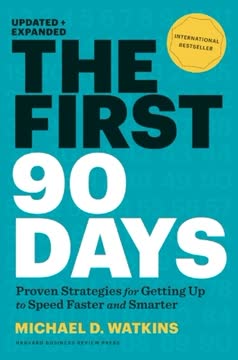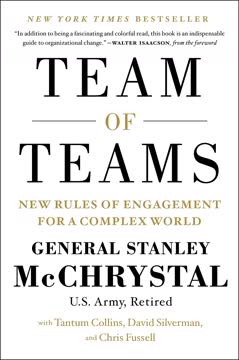Key Takeaways
1. Remote work is the future, driven by technology and changing attitudes
"Office centricity is over."
Shifting paradigm. The COVID-19 pandemic accelerated a trend towards remote work that had been slowly growing for decades. Companies like Automattic, with 1,200 employees in 77 countries, have shown that remote work can be successful at scale. Research has consistently demonstrated that remote workers are often more productive and engaged than their office-bound counterparts.
Benefits and challenges. Remote work offers flexibility, reduced commute times, and access to global talent pools. However, it also presents challenges in building team cohesion and maintaining work-life balance. Leaders must adapt their management styles to support remote teams effectively.
Cultural shift. As more companies embrace remote work, there's a growing recognition that work should fit around life, not the other way around. This shift is reshaping how we think about offices, productivity, and the nature of work itself.
2. Building trust and psychological safety are crucial for remote team success
"Psychological safety is the measure of how free people on the team are to share their ideas, their experiences, and their whole selves with their team."
Foundation of success. In remote teams, trust and psychological safety become even more critical as team members lack face-to-face interactions. Leaders must actively foster an environment where team members feel comfortable expressing ideas, admitting mistakes, and being their authentic selves.
Trust-building strategies:
- Be consistent and reliable in your communication
- Show vulnerability as a leader
- Recognize and appreciate team members' contributions
- Encourage open dialogue and constructive feedback
Psychological safety tactics:
- Create opportunities for informal interactions
- Establish clear norms for respectful communication
- Celebrate diverse perspectives and ideas
- Address conflicts promptly and fairly
3. Effective communication in remote teams balances asynchronous and synchronous methods
"Asynchronous communication is the rule; synchronous is the exception."
Communication spectrum. Remote teams must master both asynchronous (e.g., email, project management tools) and synchronous (e.g., video calls, instant messaging) communication. The key is knowing when to use each method effectively.
Asynchronous benefits:
- Allows for focused, deep work
- Accommodates different time zones and schedules
- Creates a written record of decisions and discussions
Synchronous advantages:
- Builds stronger personal connections
- Facilitates real-time problem-solving
- Reduces misunderstandings through immediate feedback
Best practices:
- Establish clear communication norms and expectations
- Use the right tool for the task (e.g., email for updates, video calls for complex discussions)
- Be mindful of time zones and personal schedules
- Encourage "working out loud" to keep everyone informed
4. Virtual meetings require careful planning and facilitation to be productive
"The goal isn't to find the candidate with the best answers. The goal is to find the candidate whose existing communication preferences match those of your team."
Purposeful planning. Virtual meetings can easily become time-wasters without proper preparation. Leaders should have a clear purpose, agenda, and expected outcomes for each meeting.
Facilitation techniques:
- Start and end on time
- Encourage participation from all attendees
- Use breakout rooms for smaller group discussions
- Capture action items and follow up after the meeting
Technology considerations:
- Ensure all participants have access to necessary tools
- Test audio and video quality before important meetings
- Use features like screen sharing and virtual whiteboards effectively
Cultural aspects:
- Create opportunities for informal chat before and after meetings
- Be mindful of cultural differences in communication styles
- Rotate meeting times to accommodate different time zones
5. Remote teams can foster creativity and innovation through structured processes
"Creative thinking isn't a meeting; it's a process."
Structured creativity. While remote work may seem to hinder spontaneous creativity, structured processes can actually enhance innovation in distributed teams.
Three-stage creative process:
- Problem meeting: Define the challenge and constraints
- Idea meeting: Generate potential solutions
- Decision meeting: Evaluate and select the best ideas
Facilitation techniques:
- Use virtual whiteboards for collaborative brainstorming
- Implement silent idea generation to avoid groupthink
- Encourage diverse perspectives and "crazy" ideas
- Use breakout rooms for smaller group ideation
Tools and technologies:
- Project management platforms for tracking ideas
- Virtual collaboration tools for real-time co-creation
- Video conferencing for face-to-face discussions
- Asynchronous communication for reflection and refinement
6. Performance management in remote teams focuses on outcomes, not activity
"Focus on the outcome, not activity."
Shift in perspective. Remote work requires a fundamental change in how we measure and manage performance. Instead of monitoring hours worked or physical presence, leaders must focus on results and outcomes.
Key performance management strategies:
- Set clear, measurable objectives
- Establish regular check-ins and feedback loops
- Use project management tools to track progress
- Encourage self-reflection and self-evaluation
Challenges to address:
- Avoiding micromanagement and surveillance
- Maintaining work-life balance
- Ensuring fair evaluation across different time zones and work schedules
Benefits of outcome-focused management:
- Increased autonomy and job satisfaction
- Better alignment with company goals
- Improved work-life balance
- Enhanced productivity and innovation
7. Engagement in remote work means preventing burnout and limiting distractions
"Working from home makes it all too easy for work to become your life."
Balancing act. Remote work can lead to increased productivity, but also carries the risk of burnout and constant distractions. Leaders must help team members establish healthy boundaries and work habits.
Preventing burnout:
- Encourage regular breaks and time off
- Model healthy work-life balance as a leader
- Establish clear "work hours" and respect them
- Promote the use of vacation time
Limiting distractions:
- Create dedicated workspace at home
- Use time-blocking techniques
- Implement "do not disturb" periods
- Utilize productivity apps and tools
Fostering engagement:
- Celebrate wins and milestones
- Provide opportunities for professional development
- Encourage social connections among team members
- Regularly check in on team members' well-being
8. Saying goodbye remotely requires deliberate planning and empathy
"Goodbyes are rarely final. They're more like 'See you later on LinkedIn or at that conference.'"
Thoughtful transitions. Whether a team member is leaving or the entire team is disbanding, remote goodbyes require careful planning and execution to maintain positive relationships and team morale.
Best practices for team member departures:
- Announce the departure promptly and professionally
- Allow the departing member to say goodbye in their preferred way
- Organize a virtual farewell event if appropriate
- Ensure a smooth handover of responsibilities
Leader departure considerations:
- Provide ample notice and a clear transition plan
- Prepare a thorough handover document
- Meet individually with team members to address concerns
- Facilitate introductions to the new leader
Long-term perspective:
- Maintain professional networks through social media
- Offer to serve as a reference or mentor
- Keep the door open for future collaborations
- Reflect on lessons learned and apply them to future teams
Last updated:
FAQ
What's "Leading from Anywhere" about?
- Remote Team Management: "Leading from Anywhere" by David Burkus is a comprehensive guide on managing remote teams effectively. It covers the transition to remote work and the unique challenges it presents.
- Building Culture and Engagement: The book delves into building a strong team culture remotely, ensuring team engagement, and maintaining productivity without the traditional office environment.
- Practical Strategies: It provides practical strategies for communication, performance management, and creative problem-solving in a remote setting.
Why should I read "Leading from Anywhere"?
- Timely Insights: With the rise of remote work, understanding how to lead teams effectively from a distance is crucial for modern leaders.
- Actionable Advice: The book offers actionable advice and tools that can be immediately implemented to improve team dynamics and productivity.
- Expert Perspective: Written by a leading business thinker, it combines research with real-world examples to provide a well-rounded perspective on remote leadership.
What are the key takeaways of "Leading from Anywhere"?
- Remote Work Benefits: Remote work can increase productivity and engagement when managed correctly, as it allows for flexibility and autonomy.
- Communication is Key: Effective communication, both asynchronous and synchronous, is vital for remote team success.
- Building Trust and Culture: Establishing trust and a strong team culture remotely requires deliberate effort and strategies.
How does David Burkus suggest building a remote team culture?
- Psychological Safety: Burkus emphasizes the importance of creating a psychologically safe environment where team members feel comfortable sharing ideas and feedback.
- Shared Identity and Purpose: Developing a shared identity and purpose helps unify remote teams and align their efforts towards common goals.
- Regular Interaction: Encouraging regular, structured interactions, such as virtual coffee breaks or team rituals, can strengthen team bonds.
What are the best communication practices in "Leading from Anywhere"?
- Asynchronous First: Burkus advises prioritizing asynchronous communication to allow team members to work without constant interruptions.
- Clear and Concise Writing: Writing clearly and concisely is crucial in remote settings to avoid misunderstandings and ensure effective communication.
- Use of Technology: Leveraging the right communication tools, such as project management software and video conferencing, can enhance team collaboration.
How does "Leading from Anywhere" address performance management?
- Outcome Over Activity: The book stresses focusing on outcomes rather than monitoring activity, as presence does not equate to productivity.
- Regular Check-ins: Regular one-on-one check-ins are recommended to track progress and provide feedback, ensuring team members stay aligned with goals.
- Feedback and Autonomy: Providing constructive feedback and allowing autonomy can motivate remote workers and improve performance.
What strategies does David Burkus recommend for hiring remote teammates?
- Trial Periods: Implementing trial periods allows both the company and the candidate to assess fit and collaboration skills before making a long-term commitment.
- Focus on Communication Skills: Hiring should prioritize candidates with strong communication skills, as these are crucial for remote work success.
- Self-Motivation Assessment: Evaluating a candidate's self-motivation and ability to work independently is essential for remote roles.
How can leaders keep remote teams engaged according to "Leading from Anywhere"?
- Avoid Burnout: Setting clear boundaries and encouraging work-life balance can prevent burnout among remote workers.
- Limit Distractions: Helping team members establish boundaries and focus can reduce distractions and improve productivity.
- Celebrate Wins: Regularly recognizing achievements and milestones can boost morale and engagement in remote teams.
What are the challenges of remote work highlighted in "Leading from Anywhere"?
- Loneliness and Isolation: Remote work can lead to feelings of loneliness, which can impact team cohesion and individual well-being.
- Communication Barriers: Without face-to-face interaction, miscommunication can occur more frequently, requiring deliberate efforts to overcome.
- Performance Monitoring: Traditional methods of performance monitoring are less effective remotely, necessitating a shift to outcome-based assessments.
How does "Leading from Anywhere" suggest handling virtual meetings?
- Purposeful Planning: Meetings should have a clear purpose and agenda to ensure they are productive and not just a time sink.
- Engagement Techniques: Using techniques like breakout rooms and interactive discussions can keep virtual meetings engaging and effective.
- Limit Frequency: Meetings should be used sparingly, with asynchronous communication as the default to allow for focused work time.
What are some notable quotes from "Leading from Anywhere" and their meanings?
- "Focus on the outcome, not the activity." This quote emphasizes the importance of measuring success by results rather than the amount of time spent working.
- "Remote work is working." It highlights the effectiveness of remote work when managed properly, challenging traditional office norms.
- "Communication is the oxygen of any relationship." This underscores the critical role of communication in maintaining strong team dynamics, especially remotely.
How does "Leading from Anywhere" address saying goodbye to team members?
- Celebrate Departures: The book suggests celebrating departures as a positive transition, similar to a graduation, rather than a loss.
- Plan for Transitions: Leaders should prepare for transitions by ensuring knowledge transfer and maintaining team morale.
- Maintain Connections: Encouraging ongoing connections through social networks can keep former team members engaged with the company community.
Review Summary
Leading from Anywhere receives mostly positive reviews, with readers praising its practical advice for managing remote teams. Many found it timely and helpful, particularly for those new to remote work. Readers appreciated the book's coverage of topics like virtual meetings, team building, and maintaining productivity. Some criticisms include its introductory nature and lack of depth in certain areas. Overall, reviewers found it a useful resource for navigating the challenges of remote leadership, with many implementing its suggestions in their own work environments.
Similar Books










Download PDF
Download EPUB
.epub digital book format is ideal for reading ebooks on phones, tablets, and e-readers.





